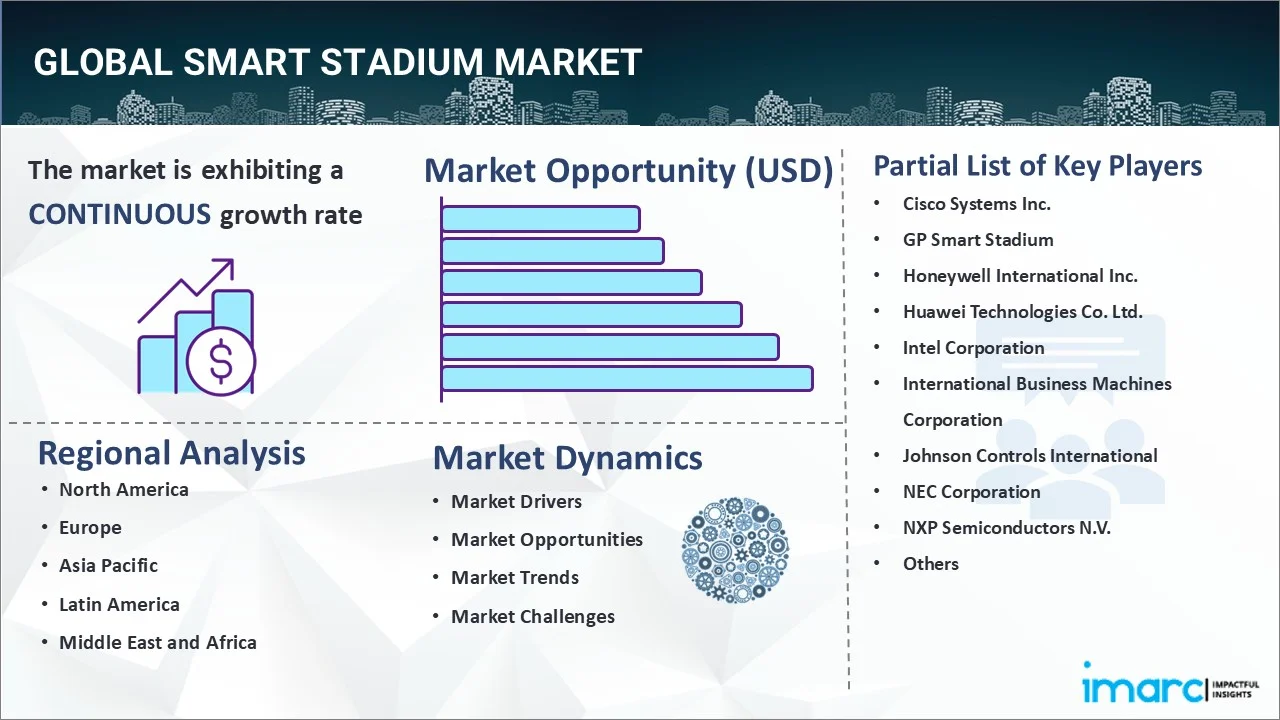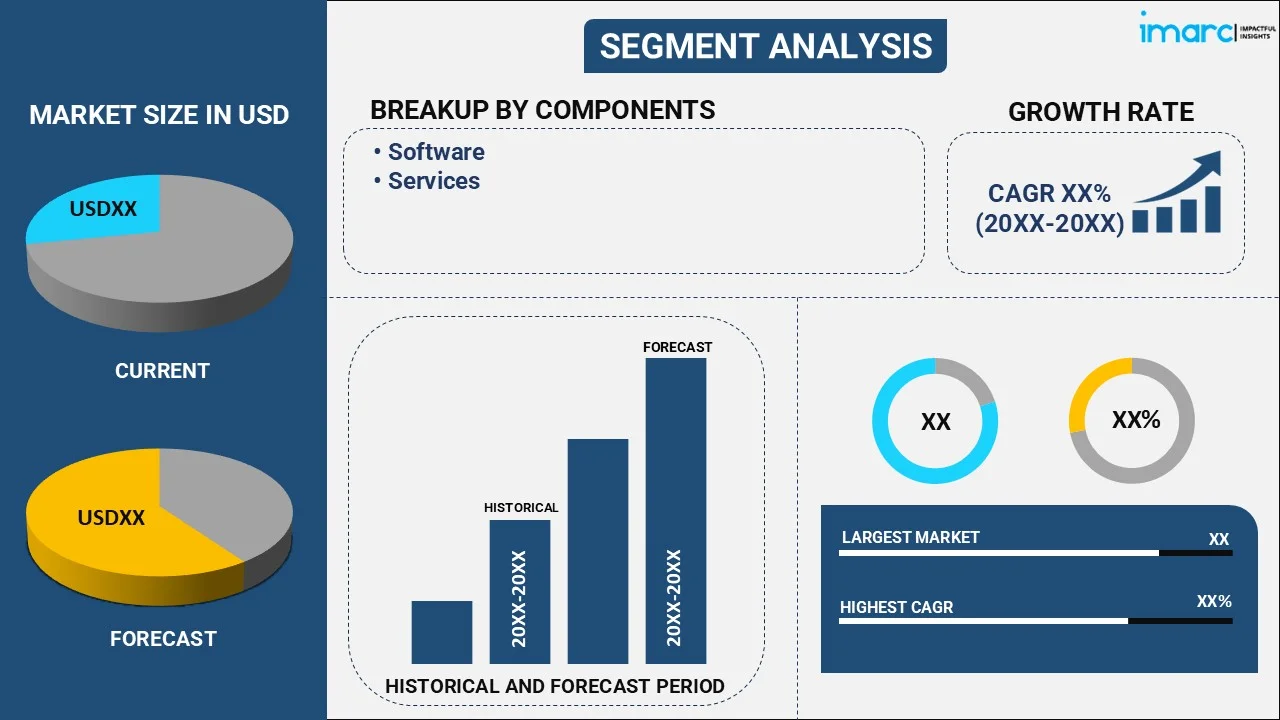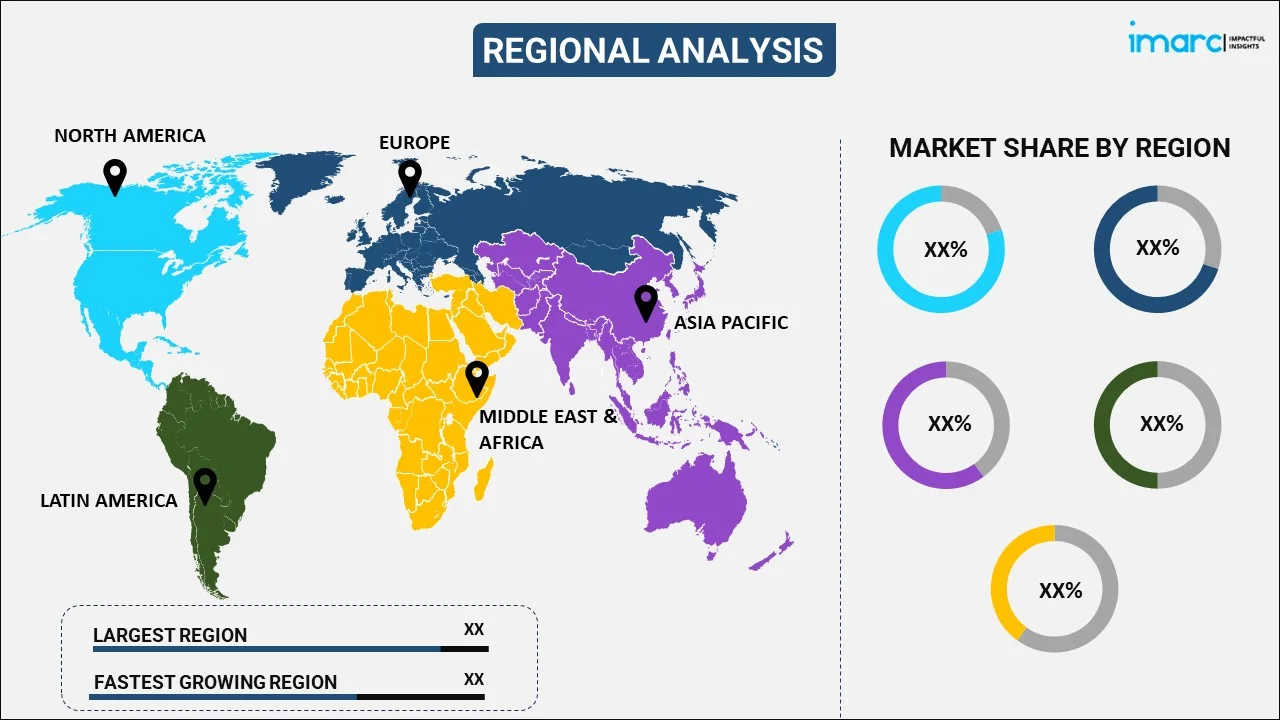
Smart Stadium Market Report by Component (Software, Services), Deployment Model (On-premises, Cloud-based), Application (Digital Content Management, Stadium and Public Security, Building Automation Management, Event Management, Crowd Management, Network Management, and Others), and Region 2025-2033
Smart Stadium Market Size:
The global smart stadium market size reached USD 10.5 Billion in 2024. Looking forward, IMARC Group expects the market to reach USD 49.0 Billion by 2033, exhibiting a growth rate (CAGR) of 17.75% during 2025-2033. There are various factors that are driving the market, which include rising focus on fan experience enhancement, introduction of advanced network technologies such as (5G) technology, popularity of various sports events, and increasing energy-efficiency concerns.
|
Report Attribute
|
Key Statistics
|
|---|---|
|
Base Year
|
2024
|
|
Forecast Years
|
2025-2033
|
|
Historical Years
|
2019-2024
|
|
Market Size in 2024
|
USD 10.5 Billion |
|
Market Forecast in 2033
|
USD 49.0 Billion |
| Market Growth Rate 2025-2033 | 17.75% |
Smart Stadium Market Analysis:
- Major Market Drivers: One of the key market drivers includes investments and partnerships. Moreover, there is an increase in the focus on enhancing operational efficiency, which is acting as a growth-inducing factor.
- Key Market Trends: The rising focus on fan experience enhancement and the introduction of advanced network technologies are the main trends in the market.
- Geographical Trends: As per the report, Europe exhibits a clear dominance, accounting for the biggest market share due to the presence of well-established technological infrastructure.
- Competitive Landscape: Various companies in the smart stadium industry are Cisco Systems Inc., GP Smart Stadium, Honeywell International Inc., Huawei Technologies Co. Ltd., Intel Corporation, International Business Machines Corporation, Johnson Controls International, NEC Corporation, NXP Semiconductors N.V., Schneider Electric SE, Tech Mahindra Limited (Mahindra Group), Telefonaktiebolaget LM Ericsson., among many others.
- Challenges and Opportunities: High initial investment and data security and privacy concerns are some major market challenges. Nonetheless, the increasing need for smart ticketing solutions and the rising focus on data analytics and insights represent key opportunities in the market.

Smart Stadium Market Trends:
Rising Focus on Fan Experience Enhancement
Technologies like augmented reality (AR), virtual reality (VR), and high-definition displays provide fans with immersive and interactive viewing experiences. Advanced data analytics and AI enable personalized services for fans such as tailored notifications, seat upgrades, and customized food product offerings. On 23 March 2023 , Evolv Technology announced that it has been named the Official Fan Screening Provider of Acrisure Stadium, home of the NFL’s Pittsburgh Steelers. Evolv’s state-of-the-art Evolv Express® screening solution is located at Acrisure Stadium’s busiest gates, screening many fans as they enter the venue. Acrisure Stadium hosts concerts and other events as well. Evolv Express uses powerful sensor technology with AI to provide safer and more accurate threat detection at unprecedented volume and speed. Fans walk through without always stopping or having to open bags. Evolv’s technology allows security officials to differentiate between threats and the everyday items people carry in their pockets and bags, which reduces long lines and allows guests to make their way directly into the stadium without invasive security experiences.
Introduction of Advanced Network Technologies
The integration of the Internet of Things (IoT) devices and enhanced connectivity allows for real time data collection and analysis, improving operational efficiency and fan experience, which is impelling the smart stadium market growth. Moreover, the deployment of 5G networks in stadiums enables faster and more reliable connectivity, enhancing the use of high-tech solutions like AR and VR. On 10 May 2024 , Midea, AIS, China Unicom, and Huawei jointly implemented the first 5G fully connected factory in Southeast Asia, setting a new standard for smart manufacturing in the region. This collaboration marks a new milestone in the 5G era, enhancing efficiency, safety, and automation in complex production processes. Harnessing the comprehensive 5G network coverage of the Midea Industrial Park in Chonburi and a 5G+ industrial Internet platform, each production phase is seamlessly connected through 5G terminals to enable faster machine operation.
Increasing Energy-Efficiency Concerns
The rising focus on energy-efficiency is catalyzing the demand for smart stadiums. Energy-efficient lighting and heating, ventilation, and air conditioning (HVAC) systems reduce operational costs and promote sustainability. In addition, the integration of renewable energy sources such as solar panels, contributes to the sustainability goals of stadiums. Furthermore, key companies are partnering with other players to improve the sustainability of their stadiums. For example, on 23 February 2024 , Orange Business co-innovated a solution in partnership with Cisco. The 67,000 capacity Orange Vélodrome stadium, located in Marseille, in the south of France, is an important technology testbed for Orange. As well as providing a public Wi-Fi network, the stadium is also used as a live experimentation platform for 5G services and applications. It is now serving as a key venue to examine energy efficiency. The company is looking to enhance sustainability in the stadium and reduce its carbon footprint.
Smart Stadium Market Segmentation:
IMARC Group provides an analysis of the key trends in each segment of the market, along with forecasts at the global, regional, and country levels for 2025-2033. Our report has categorized the market based on component, deployment model, and application.
Breakup by Component:

- Software
- Services
Software accounts for the majority of the market share
The report has provided a detailed breakup and analysis of the market based on the component. This includes software and services. According to the report, software represented the largest segment.
Software solutions analyze fan behavior and help in personalizing services and marketing strategies, thereby increasing fan satisfaction and revenue. Moreover, software solutions that integrate social media platforms enable fans to share their experiences and engage with teams and events. Besides this, data analytics software helps stadium operators monitor and optimize operations, ranging from crowd management to concession sales, ensuring efficient management. Furthermore, software-driven AI surveillance systems enhance security by monitoring crowd behavior, detecting anomalies, and preventing potential threats.
Breakup by Deployment Model:
- On-premises
- Cloud-based
On-premises hold the largest share of the industry
A detailed breakup and analysis of the market based on the deployment model have also been provided in the report. This includes on-premises and cloud-based. According to the report, on-premises accounted for the largest market share.
On-premises solutions provide stadium operators with full control over their data, ensuring higher levels of security and privacy. They allow for extensive customization to meet the specific needs and requirements of individual stadiums, enabling tailored solutions. With on-premises deployment, data remains within the stadium's infrastructure, reducing the risk of breaches and ensuring compliance with data protection regulations. Furthermore, on-premises solutions help stadium operators comply with local and international regulations, as they have greater control over data storage and processing.
Breakup by Application:
- Digital Content Management
- Digital Signage
- Audio and Video Management
- Others
- Stadium and Public Security
- Video Surveillance
- Cybersecurity
- Emergency and Disaster Management
- Physical Security Information Management
- Security Scanning, Imaging and Metal Detection
- Others
- Building Automation Management
- Parking Management Systems
- Energy Management Systems
- Facility Management Systems
- Event Management
- Event Marketing and Management
- Ticketing Management
- Workforce Management
- Crowd Management
- Network Management
- Others
Building automation management represents the leading market segment
The report has provided a detailed breakup and analysis of the market based on the application. This includes digital content management (digital signage, audio and video management, and others), stadium and public security (video surveillance, cybersecurity, emergency and disaster management, physical security information management, security scanning, imaging and metal detection, and others), building automation management (parking management systems, energy management systems, and facility management systems), event management (event marketing and management, ticketing management, and workforce management), crowd management, network management, and others. According to the report, building automation management represented the largest segment.
Building automation management systems provide a centralized platform to control various stadium operations such as lighting, HVAC, and energy management, leading to streamlined and efficient operations. Automating routine tasks like lighting adjustments, temperature control, and energy distribution reduces manual intervention and operational costs. Smart building management systems optimize energy usage by adjusting lighting, heating, and cooling based on real time occupancy and weather conditions, leading to significant energy savings. These systems help stadiums achieve sustainability goals by reducing their carbon footprint and ensuring compliance with environmental regulations.
Breakup by Region:

- North America
- United States
- Canada
- Asia-Pacific
- China
- Japan
- India
- South Korea
- Australia
- Indonesia
- Others
- Europe
- Germany
- France
- United Kingdom
- Italy
- Spain
- Russia
- Others
- Latin America
- Brazil
- Mexico
- Others
- Middle East and Africa
Europe leads the market, accounting for the largest smart stadium market share
The report has also provided a comprehensive analysis of all the major regional markets, which include North America (the United States and Canada); Asia Pacific (China, Japan, India, South Korea, Australia, Indonesia, and others); Europe (Germany, France, the United Kingdom, Italy, Spain, Russia, and others); Latin America (Brazil, Mexico, and others); and the Middle East and Africa. According to the report, Europe represents the largest regional market for smart stadium.
Europe has a well-established technological infrastructure, which facilitates the implementation of advanced smart stadium solutions. High levels of innovation and investment in research and development (R&D) efforts in the region contribute to the adoption of cutting-edge technologies in stadiums. Moreover, collaborations between sports clubs, technology companies, and governing authorities foster the development of innovative smart stadium solutions. On 15 August 2023, the new Aviva Stadium at Lansdowne Road, Dublin, was developed by engineers Kentz Ireland Ltd on behalf of the Irish Rugby Football Union and the Football Association of Ireland. It has a capacity for 50,000 spectators who can enjoy a safe and secure experience with minimum intrusion and inconvenience. Johnson Controls was selected to provide a solution for the venue that integrates fire and life systems with CCTV, access control, and intruder alarms, linked by the stadium‘s information technology (IT) infrastructure.
Competitive Landscape:
- The market research report has also provided a comprehensive analysis of the competitive landscape in the market. Detailed profiles of all major companies have also been provided. Some of the major market players in the smart stadium industry include Cisco Systems Inc., GP Smart Stadium, Honeywell International Inc., Huawei Technologies Co. Ltd., Intel Corporation, International Business Machines Corporation, Johnson Controls International, NEC Corporation, NXP Semiconductors N.V., Schneider Electric SE, Tech Mahindra Limited (Mahindra Group), and Telefonaktiebolaget LM Ericsson.
(Please note that this is only a partial list of the key players, and the complete list is provided in the report.)
- Key players in the market are developing and enhancing their technologies to improve fan experience and operational efficiency. They are collaborating with various stadiums and sports organizations to deploy their advanced solutions and provide real time data analytics. For instance, on 12 September 2023, JIG-SAW and Climatec, LLC. partnered to transform Petco Park, home of the San Diego Padres, into a connected and intelligent venue using JIG-SAW IoT technology. Through this collaboration, JIG-SAW and Climatec will enable complete visibility and control of the stadium to make Petco Park the definitive sports experience for fans and the Padres.
Smart Stadium Market News:
- 15 February 2023: Fujitsu and EintrachtTech GmbH's digital center "Arena of IoT" partnered to increase sustainability in stadium management at Deutsche Bank Park as part of a joint project. The digital center develops the most ambitious IoT ecosystem in European sports. An existing sensor solution from Mainova AG already evaluates data at the stadium on the condition of training pitches and green areas, transmitting it via a long-range wide area network (LoRaWAN) gateway.
Smart Stadium Market Report Scope:
| Report Features | Details |
|---|---|
| Base Year of the Analysis | 2024 |
| Historical Period | 2019-2024 |
| Forecast Period | 2025-2033 |
| Units | Billion USD |
| Scope of the Report | Exploration of Historical Trends and Market Outlook, Industry Catalysts and Challenges, Segment-Wise Historical and Future Market Assessment:
|
| Components Covered | Software, Services |
| Deployment Models Covered | On-premises, Cloud-based |
| Applications Covered |
|
| Regions Covered | Asia Pacific, Europe, North America, Latin America, Middle East and Africa |
| Countries Covered | United States, Canada, Germany, France, United Kingdom, Italy, Spain, Russia, China, Japan, India, South Korea, Australia, Indonesia, Brazil, Mexico |
| Companies Covered | Cisco Systems Inc., GP Smart Stadium, Honeywell International Inc., Huawei Technologies Co. Ltd., Intel Corporation, International Business Machines Corporation, Johnson Controls International, NEC Corporation, NXP Semiconductors N.V., Schneider Electric SE, Tech Mahindra Limited (Mahindra Group), Telefonaktiebolaget LM Ericsson, etc. |
| Customization Scope | 10% Free Customization |
| Post-Sale Analyst Support | 10-12 Weeks |
| Delivery Format | PDF and Excel through Email (We can also provide the editable version of the report in PPT/Word format on special request) |
Key Benefits for Stakeholders:
- IMARC’s industry report offers a comprehensive quantitative analysis of various market segments, historical and current market trends, market forecasts, and dynamics of the market from 2019-2033.
- The research report provides the latest information on the market drivers, challenges, and opportunities in the global market.
- The study maps the leading, as well as the fastest-growing, regional markets. It further enables stakeholders to identify the key country-level markets within each region.
- Porter's five forces analysis assists stakeholders in assessing the impact of new entrants, competitive rivalry, supplier power, buyer power, and the threat of substitution. It helps stakeholders to analyze the level of competition within the smart stadium industry and its attractiveness.
- The competitive landscape allows stakeholders to understand their competitive environment and provides insight into the current positions of key players in the market.
Key Questions Answered in This Report
The global smart stadium market was valued at USD 10.5 Billion in 2024.
We expect the global smart stadium market to exhibit a CAGR of 17.75% during 2025-2033.
The rising integration of smart stadiums with the Internet of Things (IoT) to enhance fan experience, provide real-time personalization, increase venue efficiency, etc., is primarily driving the global smart stadium market.
The sudden outbreak of the COVID-19 pandemic had led to the implementation of stringent lockdown regulations across several nations, resulting in the temporary halt in various live sports and entertainment activities, thereby negatively impacting the global market for smart stadiums.
Based on the component, the global smart stadium market can be categorized into software and services. Currently, software accounts for the majority of the global market share.
Based on the deployment model, the global smart stadium market has been segregated into on-premises and cloud-based, where on-premises currently exhibit a clear dominance in the market.
Based on the application, the global smart stadium market can be bifurcated into digital content management, stadium and public security, building automation management, event management, crowd management, network management, and others. Among these, building automation management holds the largest market share.
On a regional level, the market has been classified into North America, Asia-Pacific, Europe, Latin America, and Middle East and Africa, where Europe currently dominates the global market.
Some of the major players in the global smart stadium market include Cisco Systems Inc., GP Smart Stadium, Honeywell International Inc., Huawei Technologies Co. Ltd., Intel Corporation, International Business Machines Corporation, Johnson Controls International, NEC Corporation, NXP Semiconductors N.V., Schneider Electric SE, Tech Mahindra Limited (Mahindra Group), and Telefonaktiebolaget LM Ericsson.
Need more help?
- Speak to our experienced analysts for insights on the current market scenarios.
- Include additional segments and countries to customize the report as per your requirement.
- Gain an unparalleled competitive advantage in your domain by understanding how to utilize the report and positively impacting your operations and revenue.
- For further assistance, please connect with our analysts.
 Request Customization
Request Customization
 Speak to an Analyst
Speak to an Analyst
 Request Brochure
Request Brochure
 Inquire Before Buying
Inquire Before Buying




.webp)




.webp)












